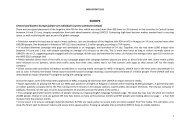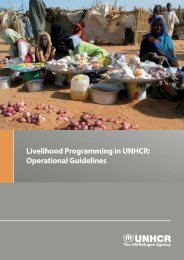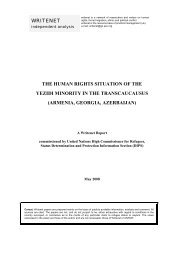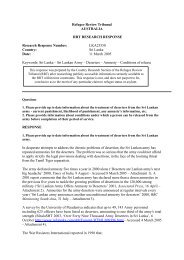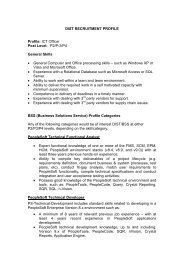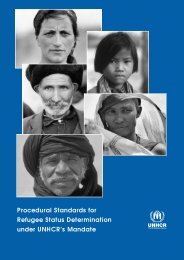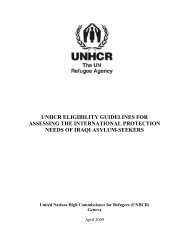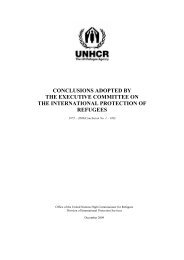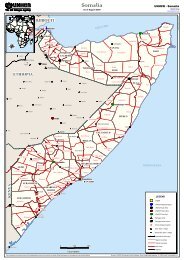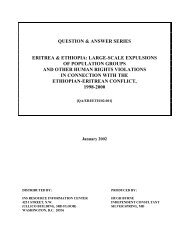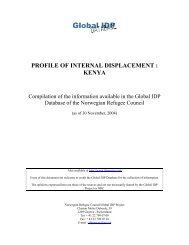UNHCR's ELIGIBILITY GUIDELINES FOR ASSESSING THE ...
UNHCR's ELIGIBILITY GUIDELINES FOR ASSESSING THE ...
UNHCR's ELIGIBILITY GUIDELINES FOR ASSESSING THE ...
Create successful ePaper yourself
Turn your PDF publications into a flip-book with our unique Google optimized e-Paper software.
underscored how explosive the conflict between Iraq’s Sunni and Shi’ite communities has<br />
become and how little the ISF is able to do in preventing the violence, if they are not<br />
themselves involved. 184<br />
Both Sunni and Shi’ite armed groups use violence to drive the other community from their<br />
areas. Systematic forced displacement serves as a tool to increase territorial influence and<br />
political leverage. 185 According to the Brookings Institution, “(t)he displacements clearly<br />
help further the political agenda of these extremist groups.” 186<br />
UNAMI reported that<br />
“(T)his forced displacement has been achieved by means of large scale attacks targeting<br />
civilians, kidnappings, extra-judicial killings, dropping of threatening leaflets, destruction<br />
of properties, and intimidation.” 187<br />
Both Sunni and Shi’ite armed groups are held responsible for widespread human rights<br />
violations directed against members of the other community or their own members if<br />
considered as “traitors”. Both sides operate largely with impunity. On the one hand, the<br />
MNF/ISF are largely unable to quell Sunni insurgent violence against civilians. On the<br />
other hand, consistent reports suggest that the Shi’ite-dominated ISF are infiltrated by<br />
militias, which collude with death squads in targeting Sunnis, e.g. through the facilitation of<br />
movement despite curfews and provision of advance warnings of upcoming security<br />
operations. 188<br />
Criminal gangs often work hand-in-hand with armed groups and militias, bolstering the<br />
latters’ sectarian agenda. 189<br />
iv) Affected Areas<br />
Particularly affected by the ongoing violence and sectarian cleansing are areas with<br />
(formerly) mixed populations such as the cities of Baghdad, Mosul and Basrah, the<br />
Governorates of Salah Al-Din and Diyala 190 (in particular Samarra, Tikrit, Balad, Dujail<br />
and Baqouba and Miqdadiyah) as well as Yusufiyah, Latifiyah and Mahmoudiyah in the socalled<br />
“Triangle of Death” south of Baghdad in the Governorate of Babel. 191 Sectarian<br />
184<br />
Nancy A. Youssef, U.S. forces move to quell sectarian violence in Balad, McClatchy Newspapers,<br />
17 October 2006, http://www.realcities.com/mld/krwashington/15782387.htm.<br />
185<br />
See, for example, Parker and Hamdani, see above footnote 104.<br />
186<br />
Al-Khalidi and Tanner, p. 1, see above footnote 161. See also: ICG, After Baker-Hamilton, p. 9, see<br />
above footnote 111, which states that “among Iraqis, the feeling is widespread that the violence is more a<br />
function of expedient calculations by politicians obsessed with their short-term survival than a deep-seated<br />
and long-term animosity between Sunnis and Shi’ites.”<br />
187<br />
UNAMI HRO, December 2006 Human Rights Report, p. 8, see above footnote 10.<br />
188<br />
US Department of Defense, p. 18, see above footnote 73; Al-Khalidi and Tanner, p. 7-8, see above<br />
footnote 161.<br />
189<br />
See “Criminal Groups”.<br />
190<br />
On the situation in the Governorate of Diyala, and in particular the town of Baqouba, see: Oppel Jr., see<br />
above footnote 123.<br />
191<br />
Al-Khalidi and Tanner, p. 16, see above footnote 161.<br />
53




